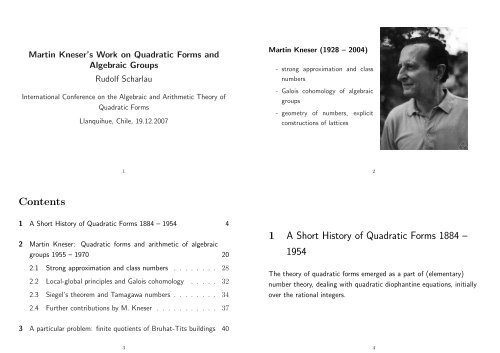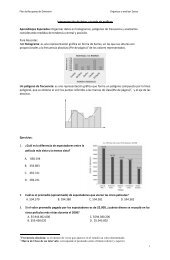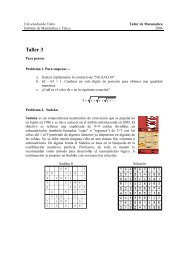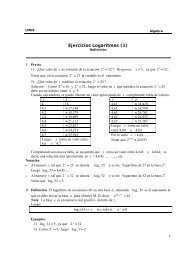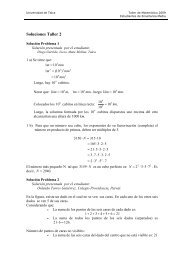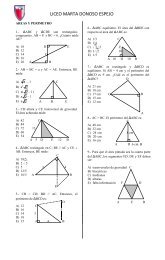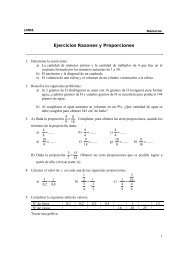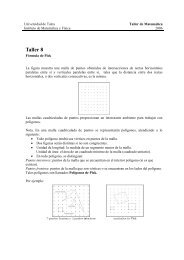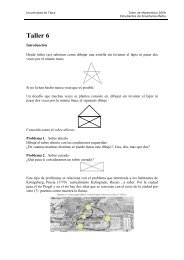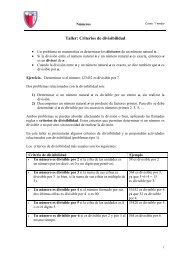Martin Kneser's work on quadratic forms and algebraic groups.
Martin Kneser's work on quadratic forms and algebraic groups.
Martin Kneser's work on quadratic forms and algebraic groups.
Create successful ePaper yourself
Turn your PDF publications into a flip-book with our unique Google optimized e-Paper software.
<str<strong>on</strong>g>Martin</str<strong>on</strong>g> Kneser’s Work <strong>on</strong> Quadratic Forms <strong>and</strong>Algebraic GroupsRudolf ScharlauInternati<strong>on</strong>al C<strong>on</strong>ference <strong>on</strong> the Algebraic <strong>and</strong> Arithmetic Theory ofQuadratic FormsLlanquihue, Chile, 19.12.2007<str<strong>on</strong>g>Martin</str<strong>on</strong>g> Kneser (1928 – 2004)- str<strong>on</strong>g approximati<strong>on</strong> <strong>and</strong> classnumbers- Galois cohomology of <strong>algebraic</strong><strong>groups</strong>- geometry of numbers, explicitc<strong>on</strong>structi<strong>on</strong>s of lattices12C<strong>on</strong>tents1 A Short History of Quadratic Forms 1884 – 1954 42 <str<strong>on</strong>g>Martin</str<strong>on</strong>g> Kneser: Quadratic <strong>forms</strong> <strong>and</strong> arithmetic of <strong>algebraic</strong><strong>groups</strong> 1955 – 1970 202.1 Str<strong>on</strong>g approximati<strong>on</strong> <strong>and</strong> class numbers . . . . . . . . 282.2 Local-global principles <strong>and</strong> Galois cohomology . . . . . 322.3 Siegel’s theorem <strong>and</strong> Tamagawa numbers . . . . . . . . 341 A Short History of Quadratic Forms 1884 –1954The theory of <strong>quadratic</strong> <strong>forms</strong> emerged as a part of (elementary)number theory, dealing with <strong>quadratic</strong> diophantine equati<strong>on</strong>s, initiallyover the rati<strong>on</strong>al integers.2.4 Further c<strong>on</strong>tributi<strong>on</strong>s by M. Kneser . . . . . . . . . . . 373 A particular problem: finite quotients of Bruhat-Tits buildings 4034
Herrmann Minkowski (1864 – 1909)The main questi<strong>on</strong>s in modern language were:a. the equivalence problem: when are to <strong>quadratic</strong> modules(“lattices”) (L,q) und (M,q ′ ) over Z equivalent ?b. The representati<strong>on</strong> problem: for which t ∈ Z does there exist ax ∈ L with q(x) = t ?c. The determinati<strong>on</strong> of the representati<strong>on</strong> numbersa(t,L) = |{x ∈ L | q(x) = t}|.He developped the foundati<strong>on</strong>s of ageneral theory of <strong>quadratic</strong> <strong>forms</strong> overthe rati<strong>on</strong>als <strong>and</strong> rati<strong>on</strong>al integers. Healready proved major results <strong>on</strong> allthree questi<strong>on</strong>s in a modern way.56A brilliant <str<strong>on</strong>g>work</str<strong>on</strong>g> of the very young Minkowski is the prize-winningpaperGrundlagen für eine Theorie der quadratischen Formen mit ganzzahligenKoeffizienten, Mémoires présentés par divers savants al’Académie des Sciences de l’institut nati<strong>on</strong>al de France, TomeXXIX, No. 2. 1884.In the main part of this paper, he develops the local classificati<strong>on</strong> ofintegral <strong>quadratic</strong> <strong>forms</strong>. In the c<strong>on</strong>text of the prize questi<strong>on</strong> <strong>on</strong> sumsof five squares, this was preparatory, but clearly of independentimportance.In his Königsberg Dissertati<strong>on</strong> from 1885 entitledUntersuchungen über quadratische Formen.Bestimmung derAnzahl verschiedener Formen, die ein gegebenes Genus enthält.Königsberg 1885; Acta Mathematica 7 (1885), 201–258he proves a versi<strong>on</strong> of the Maßformel which is already very similar tothe current <strong>on</strong>e. In c<strong>on</strong>trast to the <str<strong>on</strong>g>work</str<strong>on</strong>g>s of previous authors, the“right h<strong>and</strong> side” is a product of local densities over all primenumbers.In this c<strong>on</strong>text, Minkowski also introduces for the first time (more ofless) today’s noti<strong>on</strong> of a genus of <strong>quadratic</strong> <strong>forms</strong> (in any numberover variables).78
In those days, the rati<strong>on</strong>al theory (classificati<strong>on</strong> over Q) still was aby-product of the integral theory. Nevertheless, the following paperpractically c<strong>on</strong>tains the main theorem over Q.H. Minkowski (Letter to Hurwitz), Über die Bedingungen, unterwelchen zwei quadratische Formen mit rati<strong>on</strong>alen Koeffizienteninein<strong>and</strong>er rati<strong>on</strong>al transformiert werden können, J. reine angew.Math. 106 (1890), 5–26 = Ges. Abh. I, 219–239.To every rati<strong>on</strong>al <strong>quadratic</strong> form, Minkowski associates a system ofinvariants C p = ±1, <strong>on</strong>e for each prime. He shows that theseinvariants, together with the discriminant (a rati<strong>on</strong>al square class),determine the rati<strong>on</strong>al equivalence class. This result c<strong>on</strong>tains thelocal-global principle (for equivalence, not for representati<strong>on</strong>s), butthe term is not yet used.end Minkowski910Helmut Hasse (1898 – 1979)Carl Ludwig Siegel (1896 – 1982)One of the leading german <strong>algebraic</strong>number theorists in the 20th century- introduces Hensel’s p-adic numbersinto the theory of <strong>quadratic</strong><strong>forms</strong>- proves the (str<strong>on</strong>g) local-globalprinciple over number fields- analytic number theory- discrete <strong>groups</strong>, complex analysis- complete soluti<strong>on</strong> of the problemof representati<strong>on</strong> numbers of integral<strong>quadratic</strong> <strong>forms</strong>1112
Theorem (Minkowski, Siegel) Es sei L ein positiv definites Gitter derDimensi<strong>on</strong> l und M = M 1 ,...,M h ein Repräsentantensystem für einGeschlecht positiv definiter Gitter der Dimensi<strong>on</strong> m. Dann gilt für dieDarstellungsanzahlen a(L,M k ) v<strong>on</strong> L durch die verschiedenen M k und dielokalen Darstellungsdichten α p (L,M), p prim, die Beziehung1∑|O(M k )| −1 · ∑kka(L,M k )|O(M k )|=γ(m − l)γ(m)Hierbei sind die Werte γ(n) induktiv definiert durch∏αp (L,M).γ(0) = 1, γ(1) = 1 2 , γ(2) = 1 γ(n − 1), γ(n) = für m ≥ 3,2π n · ρ nwo ρ n das Volumen der n-dimensi<strong>on</strong>alen Einheitskugel ist.Über die analytische Theorie der quadratischen Formen I, II, III, Annals ofMathematics 36 (1935), 527–606, 37 (1936), 230–263, 38 (1937), 212–291Ernst Witt (1911 – 1991)- the founder of the moderntheory of <strong>quadratic</strong> <strong>forms</strong> overarbitrary fields- the cancellati<strong>on</strong> theorem- the extensi<strong>on</strong> theorem forisometriesTheorie der quadratischen Formen inbeliebigen Körpern, J. reine angew.Math. 176 (1937), 31–44 = Coll. Papers,Ges. Abh. 2–151314Witt was a very original mathematician; he made fundamentalc<strong>on</strong>tributi<strong>on</strong>s to diverse of topics: Witt index, Witt group, Wittvectors, to name just three. For instance, in the theory of Liealgebras, in modular <strong>forms</strong> <strong>and</strong> in <strong>algebraic</strong> combinatorics he is citedfor some st<strong>and</strong>ard results.In particular, I want to menti<strong>on</strong> Witt’s paperEine Identität zwischen Modulformen zweiten Gerades, Abh.Math. Sem. Univ. Hamburg 14 (1941), 323–337 = Coll. Papers,Ges. Abh. 313–328.It is <strong>on</strong>e of the first c<strong>on</strong>tributi<strong>on</strong>s to <strong>on</strong>going research <strong>on</strong> “lattices <strong>and</strong>modular <strong>forms</strong>”. He shows that for ˜D 16 und E 8 ⊥ E 8 , not <strong>on</strong>ly theordinary theta series, but also the sec<strong>on</strong>d degree Siegel theta seriescoincide.We shall come back to this later.end Witt1516
<str<strong>on</strong>g>Martin</str<strong>on</strong>g> Eichler (1912 – 1992)- simple algebras over numberfields- spinor norms, spinor genera- first approximati<strong>on</strong> results- modular <strong>forms</strong>, theta series<str<strong>on</strong>g>Martin</str<strong>on</strong>g> Kneser very clearly acknowledges the influence of Eichler <strong>on</strong>his own <str<strong>on</strong>g>work</str<strong>on</strong>g> in the introducti<strong>on</strong> of the 2001 book versi<strong>on</strong> of hislectures <strong>on</strong> <strong>quadratic</strong> <strong>forms</strong>:“Für all dies vergleiche man das einflußreiche WerkQuadratische Formen und orthog<strong>on</strong>ale Gruppen, Springer-Verlag 1952.”He makes precise in what sense the book was influential <strong>on</strong> himself:1718“Schließlich ein persönliches Wort. Es istziemlich genau 50 Jahre her, daß ich alsjunger Assistent nach Münster kam, baldan Eichlers Seminar teilnahm, wo geradedie neuesten Ergebnisse aus seinem BuchQuadratische Formen und orthog<strong>on</strong>ale Gruppenbesprochen wurden. Da ich im Institutmein Arbeitszimmer mit Eichler teilte, hatteich die besten Möglichkeiten, v<strong>on</strong> einer Seminarsitzungzur nächsten die offen gebliebenenFragen zu klären und so die quadratischenFormen an der Quelle zu studieren.”2 <str<strong>on</strong>g>Martin</str<strong>on</strong>g> Kneser: Quadratic <strong>forms</strong> <strong>and</strong>arithmetic of <strong>algebraic</strong> <strong>groups</strong> 1955 – 1970(M. Kneser 2001, aus der Einleitung v<strong>on</strong> Quadratische Formen)1920
In the mid 1950s, the theory of <strong>algebraic</strong> <strong>groups</strong> <strong>and</strong> the (arithmetic)theory of <strong>quadratic</strong> <strong>forms</strong> were still rather unrelated areas of research. Onthe side of <strong>groups</strong>, the classificati<strong>on</strong> of (semi)simple <strong>algebraic</strong> <strong>groups</strong> over<strong>algebraic</strong>ally closed fields was known by <str<strong>on</strong>g>work</str<strong>on</strong>g> of Claude Chevalley. JacquesTits had (essentially) introduced the structures later called buildings whichgive a uniform geometrical interpretai<strong>on</strong> of all these <strong>groups</strong>, including theexcepti<strong>on</strong>al <strong>on</strong>es.Already by the end of the 1950s, a completely new area of research hademerged, after Arm<strong>and</strong> Borel had proved his fundamental theorem <strong>on</strong> theexistence <strong>and</strong> c<strong>on</strong>jugacy of maximal c<strong>on</strong>nected solvable sub<strong>groups</strong>. Thismade the classificati<strong>on</strong> of semisimple <strong>groups</strong> over arbitrary fieldsaccessible, which was then rather quickly carried out mainly by Borel <strong>and</strong>Tits. They used k-split tori <strong>and</strong> the relative root system to reduce thequesti<strong>on</strong> essentially to the anisotropic kernel, in analogy with the Wittdecompositi<strong>on</strong> of <strong>quadratic</strong> <strong>forms</strong>.Over number fields, this approach embedded the earlier studies of algebraswith involuti<strong>on</strong>, hermitian <strong>forms</strong>, Cayley octaves <strong>and</strong> Jordan algebras intoa uniform theory. In this situati<strong>on</strong> it was perfectly natural (after <str<strong>on</strong>g>work</str<strong>on</strong>g> ofLang <strong>and</strong> Tate) to introduce n<strong>on</strong>-abelian Galois cohomology (H 0 ,H 1 ,abelian H 2 ) to treat such classificati<strong>on</strong> questi<strong>on</strong>s. Jean-Pierre Serre’scours at the Collège de France 1962-63, leading to the famous Lecturenotes No. 5 Cohomologie Galoisienne, dem<strong>on</strong>strates how quickly the newmethod had been established.The theory of semisimple <strong>groups</strong> over number fields in turn laid thefoundati<strong>on</strong>s for a general treatment of arithmetic sub<strong>groups</strong> of <strong>algebraic</strong><strong>groups</strong>, whose fundamentals were developed by Borel <strong>and</strong> Harish-Ch<strong>and</strong>ra.Clearly, many substantial results had been obtained (much) earlier mainlyby Siegel, but the frame<str<strong>on</strong>g>work</str<strong>on</strong>g> had dramatically changed.2122<str<strong>on</strong>g>Martin</str<strong>on</strong>g> Kneser’s vita- 1945-50 studies in Tübingen,Göttingen <strong>and</strong> BerlinWe now want to look at (part of) Kneser’s <str<strong>on</strong>g>work</str<strong>on</strong>g> as embedded in thisgeneral picture.- 1951-1956 assistant at Münster<strong>and</strong> Heidelberg, Habilitati<strong>on</strong>- 1957-58 Univ. of Saarbrücken- 1959-62 Prof at München- 1963–1993 Prof at Göttingen2324
Four fundamental <str<strong>on</strong>g>work</str<strong>on</strong>g>s by <str<strong>on</strong>g>Martin</str<strong>on</strong>g> Kneser:1. Klassenzahlen indefiniter quadratischer Formen,Archiv d. Math. 7 (1956), 323–3322. Klassenzahlen definiter quadratischer Formen,Archiv d. Math. 8 (1957), 241–250.3a. Str<strong>on</strong>g approximati<strong>on</strong>. in: Algebraic <strong>groups</strong> <strong>and</strong> disc<strong>on</strong>tinuoussub<strong>groups</strong>. Proceedings, Boulder Co 1965.3b. Starke Approximati<strong>on</strong> in algebraischen Gruppen.I.J. reine angew. Math. 218 (1965), 190 – 203.4. Galois-Kohomologie halbeinfacher algebraischer Gruppenüber p-adischen Körpern I. <strong>and</strong> II.Math. Z.88 (1965), 40–47, 89 (1965), 250–272c<strong>on</strong>tents of the paper in Archiv d. Math. 1956:- proof of the str<strong>on</strong>g approximati<strong>on</strong> theorem for representati<strong>on</strong>s<strong>and</strong> for the orthog<strong>on</strong>al group- the adelic orthog<strong>on</strong>al group is introduced for the first time- the number of spinor genera in a genus is a group index- generati<strong>on</strong> of orthog<strong>on</strong>al <strong>groups</strong> by reflecti<strong>on</strong>s- computati<strong>on</strong> of local spinor norms2526c<strong>on</strong>tents of the paper in Archiv d. Math. 1957:- main idea: if (V,q) is isotropic at p, lattice over Z[1/p] behavelike indefinite lattices- technically: apply str<strong>on</strong>g approximati<strong>on</strong> (from the previous paper)to the set of places S = ∞ ∪ {p}- for any two classes in the same spinor genus, there arerepresentatives L,M s.t. Z[1/p]L = Z[1/p]M.- the resulting “neighbour method” is used to calculate the classnumber of I n up to dimensi<strong>on</strong> 14.2.1 Str<strong>on</strong>g approximati<strong>on</strong> <strong>and</strong> class numbersWe have already talked, without details, about the use of str<strong>on</strong>gapproximati<strong>on</strong> for class numbers <strong>and</strong> representati<strong>on</strong>s of <strong>quadratic</strong><strong>forms</strong>. We now generalize the situati<strong>on</strong> to <strong>algebraic</strong> <strong>groups</strong> <strong>and</strong> givecomplete definiti<strong>on</strong>s <strong>and</strong> statements.Notati<strong>on</strong>:2728
k an <strong>algebraic</strong> number fieldo the ring of integers of kp,l,v,... places (equivalence classes of valutati<strong>on</strong>s of k)k p ,o p the completi<strong>on</strong> of k, resp. o at pp ∈ o p a prime element for p, if p is finiteS kSA = A kthe set of all places of ka finite set of places of kthe ring of adeles of k(a l ) l∈Sk a typical element of A, so a l ∈ o l f.a.a. lA(S) ⊂ A the S-integral ideles, so a l ∈ o l for l /∈ SVGLG(R)G(A k )G(o)G(k) ⊂ G(A k )a finite-dimensi<strong>on</strong>al vector space over ka linear <strong>algebraic</strong> group defined over oa lattice in Vfor any over-ring R ⊇ o the group of R-points in Gin particularthe adele-group of G over kthe stabilizer of L in G(k)diag<strong>on</strong>ally embedded2930Definiti<strong>on</strong> 1 The G-class number of a lattice L is the number ofG-classes in the G-genus of L.Definiti<strong>on</strong> 2 (Str<strong>on</strong>g Approximati<strong>on</strong>) Let G be an <strong>algebraic</strong>group over k <strong>and</strong> S be a finite set of places of k. We say that str<strong>on</strong>gapproximati<strong>on</strong> holds for the pair (G,S) if G(k)G(A(S)) is dense inG(A k ).Theorem 1 (Kneser 1965, Plat<strong>on</strong>ov 1969)Str<strong>on</strong>g approximati<strong>on</strong> holds for all pairs (G,S), where G is simplyc<strong>on</strong>nected almost k-simple <strong>and</strong> G(k v ) is not compact for at least <strong>on</strong>ev ∈ S.2.2 Local-global principles <strong>and</strong> Galois cohomologyDefiniti<strong>on</strong> 3 The Hasse principle holds for an <strong>algebraic</strong> group G overk if the can<strong>on</strong>ical mapH 1 (k,G) → ∏v∈S kH 1 (k v ,G)is injective.The following result is fundamental for the use of this method:Theorem 2 (Kneser 1965) If G is a semisimple simply c<strong>on</strong>nectedgroup over a local field k of characteristic 0, then H 1 (k,G) = 0.The proof uses the classificati<strong>on</strong> <strong>and</strong> structure theory of such <strong>groups</strong>,but also a lot of case-by-case investigati<strong>on</strong>s.3132
2.4 Further c<strong>on</strong>tributi<strong>on</strong>s by M. KneserTo finish this partial overview of Kneser’s <str<strong>on</strong>g>work</str<strong>on</strong>g>, I want to menti<strong>on</strong>three doctoral dissertati<strong>on</strong>s which were supervised by him. This is mypers<strong>on</strong>al choice.H.-V. Niemeier, Definite quadratische Formen der Diskriminante 1und Dimensi<strong>on</strong> 24, J. Number Theory 5 (1973), 142–178.Jürgen Biermann: Gitter mit kleiner Automorphismengruppe inGeschlechtern v<strong>on</strong> Z-Gittern mit positiv-definiter quadratischer Form,Dissertati<strong>on</strong> Göttingen 1981Yuriko Suwa-Bier Positiv definite quadratische Formen mit gleichenDarstellungsanzahlen, Dissertati<strong>on</strong> Göttingen 1984In c<strong>on</strong>strast to a first impressi<strong>on</strong>, this is not a questi<strong>on</strong> about thetaseries. It requires a carefully chosen (<strong>and</strong> eventually computer-based)decompositi<strong>on</strong> of the 12-dimensi<strong>on</strong>al c<strong>on</strong>e of pairs of reduced positivedefinite 3 × 3-matrices.The soluti<strong>on</strong> of this problem was eventually given in the followingdissertati<strong>on</strong>, supervised by F. Grunewald:Alex<strong>and</strong>er Schiemann: Ternäre positiv definite quadratische Formenmit gleichen Darstellungsanzahlen, Dissertati<strong>on</strong> B<strong>on</strong>n 19933738Finally, I want to menti<strong>on</strong> three papers by Kneser himself, which dealwith <strong>quadratic</strong> <strong>forms</strong>, but outside the main scope of his <str<strong>on</strong>g>work</str<strong>on</strong>g>s.Zur Theorie der Kristallgitter,Math. Annalen 127, 105–106 (1954)Two remarks <strong>on</strong> extreme <strong>forms</strong>, Canadian Journal of Math.7, 145–149 (1955)Lineare Relati<strong>on</strong>en zwischen Darstellungsanzahlen quadratischerFormen, Math. Annalen 168, 31–39 (1967)3 A particular problem: finite quotients ofBruhat-Tits buildingsIn the 1980s: Finite group theorists <strong>and</strong> geometers <str<strong>on</strong>g>work</str<strong>on</strong>g> <strong>on</strong> the classificati<strong>on</strong> ofcertain classes of (locally) finite incidence geometries bel<strong>on</strong>ging to a Coxeterdiagram (<strong>and</strong> more general diagrams), together with a flag transitiveautomorphism group. The maximal flags are called “chambers”, the term“chamber system” is also comm<strong>on</strong>. These geometries locally look like finitebuildings.There is an appropriate covering theory for chamber systems (related to groupamalgamati<strong>on</strong>s), <strong>and</strong> the universal 2-cover under rather general assumpti<strong>on</strong>s is abuilding. If the diagram bel<strong>on</strong>gs to the known list of affineCoxeter-Dynkin-diagrams <strong>and</strong> the rank is ≥ 4, then this building is known: it as aBruhat-Tits building.3940
A general reference is the following:ko,p,k p ,o pG ⊂ GL(V )a totally real <strong>algebraic</strong> number fieldas beforesimply c<strong>on</strong>nected semisimple, almost simple over kWilliam M. Kantor: Finite geometries via <strong>algebraic</strong> affine buildings,pp. 37-44 in: Finite Geometries, Buildings <strong>and</strong> Related Topics (Eds.W. M. Kantor et al.), Oxford University Press, Oxford 1990Other c<strong>on</strong>tributors: Timmesfeld, Stroth, R<strong>on</strong>an, Meixner.We maintain the general notati<strong>on</strong> introduced preciously; in particular,we c<strong>on</strong>sider the following:anisotropic at the infinite placesp a fixed finite place of k s.t. rk p G ≥ 2¯k p := o/po the residue field at p∆ := ∆(G(k p )) the Bruhat-Tits building of G(k p ).La lattice in V s.t. o p L =: L p defines a vertex of ∆∆ 0∼ = ∆(G(¯kp )) the residue (star, link) of L in ∆.Γ := G(o[ 1 p ]) a {p}-arithmetic discrete subgroup of G(k p)Γ 0 := G(o)the finite stabilizer of L in G(k).4142The following unpublished result grew out of discussi<strong>on</strong>s betweenWilliam M. Kantor, <str<strong>on</strong>g>Martin</str<strong>on</strong>g> Kneser <strong>and</strong> myself in the early 90s.Propositi<strong>on</strong> (M. Kneser, unpublished) Under the aboveassumpti<strong>on</strong>s, the following properties of the lattice L (resp. thearithmetic <strong>groups</strong> Γ, Γ 0 ) are equivalent:• Γ acts chamber transitively <strong>on</strong> ∆.• (i) Γ 0 acts chamber transitively <strong>on</strong> ∆ 0 ,(ii) h G (L) = 1.Proof: “=⇒”: (i) is obvious from the assumpti<strong>on</strong>, since thechambers of ∆ 0 are exactly the chambers of ∆ c<strong>on</strong>taining the vertexL. For (ii), we have to show thatG(A k ) = G(k) · G(A(∞)). (1)Since G is isotropic at p, we can use str<strong>on</strong>g approximati<strong>on</strong> for the setof places ∞ ∪ {p}:G(A k ) = G(k) · G(A(∞ ∪ {p})). (2)Since Γ acts chamber transitively <strong>on</strong> ∆ it acts also vertex transitively<strong>on</strong> the vertices of a given type, which for “type L” translates asG(k p ) = Γ · G(o p ) = G(o[ 1 p ]) · G(o p). (3)4344
Given an arbitrary idele (σ l ) ∈ G(A k ), first use (2) <strong>and</strong> write it asσ · (τ l ) with σ ∈ G(k) <strong>and</strong> τ l ∈ G(o l ) for all l ≠ p. Then use (3) <strong>and</strong>write τ p = γ · δ with γ ∈ G(o[ 1 p ]) <strong>and</strong> δ ∈ G(o p). Now replace theoriginal decompositi<strong>on</strong> of (σ l ) byσ l = (σγ) · (γ −1 τ l ) for all l.Since p is a unit in all o l ,l ≠ p, we have γ ∈ G(o l ) for all l ≠ p <strong>and</strong>thus γ −1 τ l is still in G(o l ). Furthermore, γ −1 τ p = δ is in G(o p ) byc<strong>on</strong>structi<strong>on</strong>. Thus the sec<strong>on</strong>d factor of the new decompositi<strong>on</strong> is inG(o l ) for all l, <strong>and</strong> therefore the given idele is a member of the righth<strong>and</strong> side of (1).“⇐=”: Because of assumpti<strong>on</strong> (i), we <strong>on</strong>ly have to show thetransitivity of Γ <strong>on</strong> the vertices of “type L”, that is, the vertices inthe orbit G(k p )L ⊂ ∆. But this transitivity is equivalent to (3), ashas already been used. To prove (3), just apply assumpti<strong>on</strong> (1) toideles which are 1 outside p: for any given σ p ∈ G(k p ), there existsσ ∈ G(k) <strong>and</strong> an idele (τ l ) with τ l ∈ G(o l ) for all l s.t. σ p = σ · τ p<strong>and</strong> σ · τ l = 1 for all l ≠ p. But this means σ ∈ G(o p ) for all l ≠ p,thus σ ∈ G(o[ 1 ]), as desired.□p4546Notice: This proof is completely analogous to the derivati<strong>on</strong> of theneighbour method from str<strong>on</strong>g approximati<strong>on</strong>. See in particularequati<strong>on</strong> (3) <strong>and</strong> compare Kneser’s 1957 paper.C<strong>on</strong>sequences: Discrete chamber transitive <strong>groups</strong> <strong>on</strong> affinebuildings are very rare. Examples had been found in the <str<strong>on</strong>g>work</str<strong>on</strong>g>s ofKantor <strong>and</strong> Meixner/Wester in the above-menti<strong>on</strong>ed c<strong>on</strong>text.A full classificati<strong>on</strong> has been announced in[KLT] W.M. Kantor, R. Liebler, J. Tits, On discrete chamber-transitive automorphism <strong>groups</strong> of affine buildings,Notices of the AMS Vol. 16, No. 1 (1987).The “generic case” of the suggested proof deals with then<strong>on</strong>-existence of such a subgroup for almost all <strong>algebraic</strong> <strong>groups</strong> G. Itis briefly sketched in that announcement (see also the survey quotedabove). It uses <strong>on</strong>ly c<strong>on</strong>diti<strong>on</strong> (i) (or rather the chamber transtivity<strong>on</strong> residues of all types). This c<strong>on</strong>diti<strong>on</strong> is already very restrictive, bya theorem of Gary Seitz. A complete proof of the classificati<strong>on</strong> to myknowledge did not appear. A proof of the finiteness result based <strong>on</strong>the computati<strong>on</strong> of covolumes of S-arithmetic <strong>groups</strong> has been givenby Prasad <strong>and</strong> Borel/Prasad (two subsequent papers in Publ. Math.IHES) already in 1989.The class number c<strong>on</strong>diti<strong>on</strong> (ii) could be used to shorten an eventualcomplete proof. For orthog<strong>on</strong>al <strong>groups</strong>, <strong>on</strong>e could use the results <strong>on</strong>the growth of class numbers of the 1972 dissertati<strong>on</strong> of HorstPfeuffer, again a student of Kneser. For other <strong>groups</strong>, it is apparentlynecessary to <str<strong>on</strong>g>work</str<strong>on</strong>g> out explicitly the above-menti<strong>on</strong>ed formulas of(Borel <strong>and</strong>) Prasad <strong>on</strong> covolumes of arithmetic <strong>groups</strong>.4748


